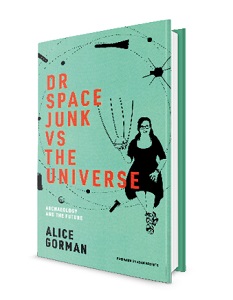It’s not every day you come across a space archaeologist – one could almost consider it an oxymoron – but that is the trench this author has dug for herself. According to the introductory text, Gorman “investigates the archaeology and heritage of space junk [hence her nickname], planetary landing sites, rocket launches and antennas”. Reflecting the current vernacular, this paperback book is part popular space education and part autobiography. Subtitled ‘Archaeology and the Future’, it includes chapters on ‘How I became a Space Archaeologist’, ‘Junkyard Earth’ and ‘Whose Space is it Anyway?’.
Despite the inclusive writing style, the volume includes seven pages of references and an eight-page, double-column index, but those expecting illustrations will be disappointed. This book relies on its words to paint the pictures and therein lies one of its problems. The lack of illustrations and the somewhat generic chapter headings (Journey into Space, Shadows on the Moon…) make it difficult to gauge what the book is supposed to be about and who it’s aimed at.
Moreover, while it seems to be implicit that potential purchasers will be interested in this Australian academic’s back story, it’s far from clear why we should care that she grew up on a farm, was “sent to an impoverished Catholic boarding school” and read a book on evolution at her Uncle John’s house. Arguably, it would have been better to lead with her undeniable expertise and include the personal stuff as ‘light relief’.
So what is the likely audience for this book? Beyond the Australian domestic audience and the author’s Twitter fans, it’s hard to say. While I appreciate her professional achievements and agree with many of her opinions on space-related subjects, I feel there are better ways to engage with a lay audience… and better books on the variety of space subjects she tries to cover.











